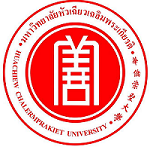Please use this identifier to cite or link to this item:
https://has.hcu.ac.th/jspui/handle/123456789/4653Full metadata record
| DC Field | Value | Language |
|---|---|---|
| dc.contributor.author | 褚亚楠 | - |
| dc.contributor.author | Chu Yanan | - |
| dc.contributor.author | 潘立慧 | - |
| dc.contributor.author | Pan Lihui | - |
| dc.contributor.other | Huachiew Chalermprakiet University. College of Chinese Studies. Graduate Student | en |
| dc.contributor.other | Guangxi University. School of Liberal Arts | en |
| dc.date.accessioned | 2025-10-13T12:33:15Z | - |
| dc.date.available | 2025-10-13T12:33:15Z | - |
| dc.date.issued | 2024 | - |
| dc.identifier.citation | วารสารวิชาการภาษาและวัฒนธรรมจีน 11, 1 (มกราคม-มิถุนายน 2567) : 217-230. | en |
| dc.identifier.uri | https://has.hcu.ac.th/jspui/handle/123456789/4653 | - |
| dc.description | สามารถเข้าถึงบทความฉบับเต็ม (Full text) ได้ที่ : https://so02.tci-thaijo.org/index.php/clcjn/article/view/261454/180669 | en |
| dc.description.abstract | 幽默是一种在各种教育环境中使用的有效方法,但是在大学教授汉语作为第二语言的情境中,其使用尚未得到充分的研究。本研究旨在通过了解泰国大学汉语口语课课堂幽默的使用情况,探讨泰国汉语口语课课堂上的幽默有哪些类型,并分析其生成机制,并在此基础上确定可用于提高学生参与度、动机 、交流意愿和学习成果的有效幽默策略。笔者以泰国艺术大学的 汉语口语课堂为采样对象,采用定性研究设计,通过课堂观察、问卷调查的方式收集数据,采用主题分析法进行数据分析。结果表明,汉语作为第二语言的大学生课堂幽默类型主要有口头幽默、肢体语言、幽默道具三种。以上幽默的特点表现为:1、大多与课程学习内容相关;2、多具偶发性;3、具有情境特定性;4、与学生的语言能力水平相关。课堂幽默的生成机制主要包括课程内容的幽默性、教师自身的幽默感、课堂气氛的营造、桥梁效应、学生个人特点等。课堂幽 默的功能主要表现在活跃课堂气氛、引发愉悦情绪、减少学习焦虑并愿意表达、激发课堂交流意愿、有利于建立良好的师生关系等。研究还发现幽默可能是文化和情境特定的,教师在课堂中使用幽默时需要考虑学生的文化背景和语言能力水平。总之,本研究有助于理解幽默在第二语言习得和教学中的作用,并为语言教师在大学中教授中文作为第二语言时有效使用幽默提供实用指导。研究结果还将提供关于学生和教师对幽默使用的态度,有助于语言教师和研究人员开发更有效的汉语作为第二语言的教学方法,为集成幽默作为有效教学工具的语言教学理论发展提供指导。 | en |
| dc.description.abstract | Humor is an effective method used in a variety of educational settings, but its use in university contexts where Chinese is taught as a second language has not been adequately studied. The purpose of this study is to find out how humor is used in Thai university classrooms of spoken Chinese, to explore what types of humor are used in Thai classrooms of spoken Chinese, and to analyze the mechanisms by which it is generated, and on this basis to identify effective humor strategies that can be used to increase student engagement, motivation, willingness to communicate, and learning outcomes. The author used a qualitative research design to collect data through classroom observations and questionnaires and used thematic analysis to analyze the data using a sampling of spoken Chinese classrooms at the University of the Arts in Thailand. The results show that the types of humor in the classroom of college students of Chinese as a second language are mainly verbal humor, body language, and humorous props. The characteristics of the above humor are: 1) mostly related to the course learning content; 2) mostly episodic; 3) context specific; 4) related to the students' language ability level. The mechanisms of classroom humor include the humor of the course content, the teacher's own sense of humor, the creation of classroom atmosphere, the bridge effect, and the students' personal characteristics. The functions of classroom humor are mainly manifested in enlivening the classroom atmosphere, triggering pleasant emotions, reducing learning anxiety and willingness to express it, stimulating the willingness to communicate in class, and contributing to the establishment of good teacher-student relationships. The study also found that humor may be culturally and contextually specific and that teachers need to consider students' cultural backgrounds and language proficiency levels when using humor in the classroom. In conclusion, this study contributes to the understanding of the role of humor in second language acquisition and teaching and provides practical guidelines for language teachers to use humor effectively when teaching Chinese as a second language in universities. The findings will also provide information about students' and teachers' attitudes toward humor use, help language teachers and researchers develop more effective methods of teaching Chinese as a second language, and provide guidance for the development of language teaching theories that integrate humor as an effective teaching tool. | en |
| dc.language.iso | zh | en |
| dc.publisher | มหาวิทยาลัยหัวเฉียวเฉลิมพระเกียรติ | en |
| dc.subject | ภาษาจีน – การใช้ภาษา | en |
| dc.subject | Chinese language – Usage | en |
| dc.subject | 汉语 -- 语言使用 | en |
| dc.subject | ภาษาจีน – การศึกษาและการสอน | en |
| dc.subject | Chinese language -- Study and teaching | en |
| dc.subject | 汉语 -- 学习和教学 | en |
| dc.subject | ภาษาจีน -- การศึกษาและการสอน (อุดมศึกษา) | en |
| dc.subject | 汉语 -- 学习和教学 (大学) | en |
| dc.subject | Chinese language -- Study and teaching (Higher education) | en |
| dc.subject | ภาษาจีน – การพูด | en |
| dc.subject | Chinese language – Speaking | en |
| dc.subject | 汉语 -- 口语 | en |
| dc.subject | ภาษาจีน -- การศึกษาและการสอน – ไทย | en |
| dc.subject | Chinese language -- Study and teaching -- Thailand | en |
| dc.subject | 汉语 -- 学习和教学 -- 泰国 | en |
| dc.subject | อารมณ์ขัน | en |
| dc.subject | Wit and humor | en |
| dc.subject | 幽默 | - |
| dc.title | 对汉语作为第二语言的大学生课堂幽默研究——以泰国艺术大学为例 | en |
| dc.title.alternative | Research on Classroom Humor in Chinese Classes for University Students Learning Chinese as a Second Language Taking Silpakorn University of Thailand as an Example | en |
| dc.type | Article | en |
| Appears in Collections: | College Of Chinese Studies - Articles Journals | |
Files in This Item:
| File | Description | Size | Format | |
|---|---|---|---|---|
| Research-on-Classroom-Humor-in-Chinese-Classes-for-University-Students-Learning-Chinese-as-a-Second-Language.pdf | 264.82 kB | Adobe PDF | View/Open |
Items in DSpace are protected by copyright, with all rights reserved, unless otherwise indicated.
